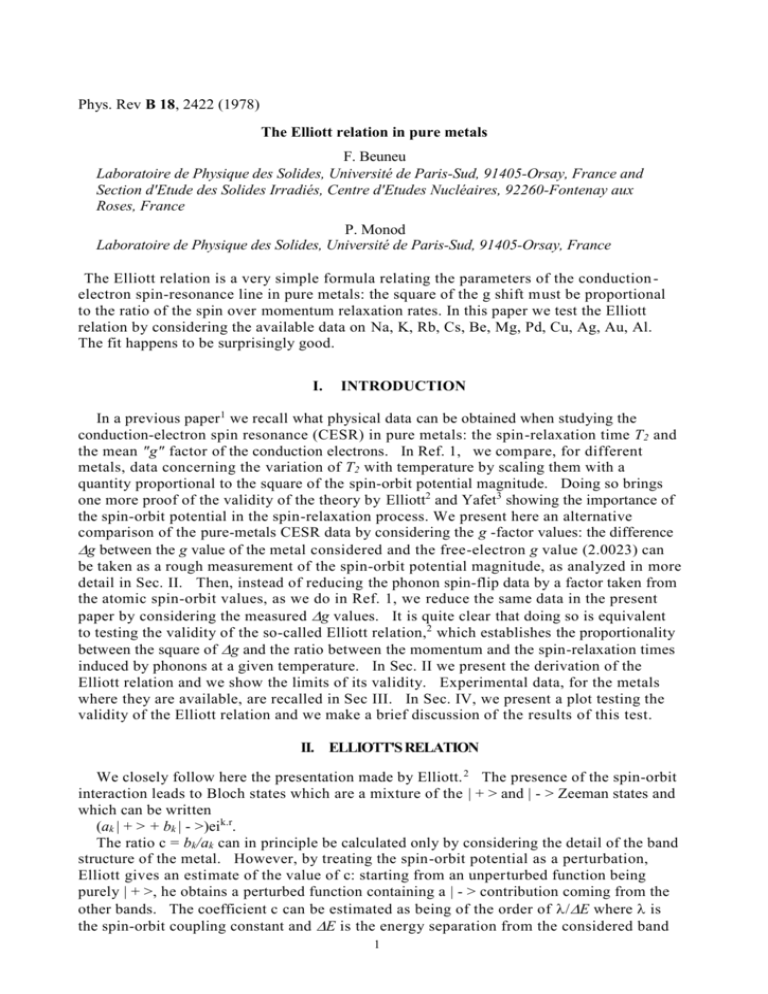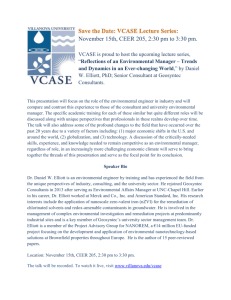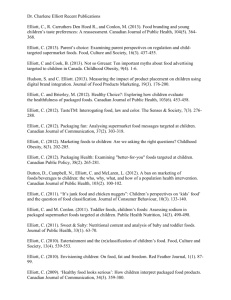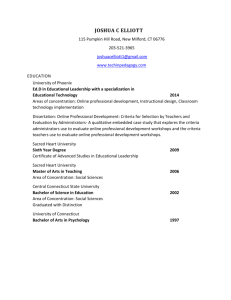The Elliott relation in pure metals
advertisement

Phys. Rev B 18, 2422 (1978) The Elliott relation in pure metals F. Beuneu Laboratoire de Physique des Solides, Université de Paris-Sud, 91405-Orsay, France and Section d'Etude des Solides Irradiés, Centre d'Etudes Nucléaires, 92260-Fontenay aux Roses, France P. Monod Laboratoire de Physique des Solides, Université de Paris-Sud, 91405-Orsay, France The Elliott relation is a very simple formula relating the parameters of the conduction electron spin-resonance line in pure metals: the square of the g shift must be proportional to the ratio of the spin over momentum relaxation rates. In this paper we test the Elliott relation by considering the available data on Na, K, Rb, Cs, Be, Mg, Pd, Cu, Ag, Au, Al. The fit happens to be surprisingly good. I. INTRODUCTION In a previous paper1 we recall what physical data can be obtained when studying the conduction-electron spin resonance (CESR) in pure metals: the spin-relaxation time T 2 and the mean "g" factor of the conduction electrons. In Ref. 1, we compare, for different metals, data concerning the variation of T2 with temperature by scaling them with a quantity proportional to the square of the spin-orbit potential magnitude. Doing so brings one more proof of the validity of the theory by Elliott2 and Yafet3 showing the importance of the spin-orbit potential in the spin-relaxation process. We present here an alternative comparison of the pure-metals CESR data by considering the g -factor values: the difference g between the g value of the metal considered and the free-electron g value (2.0023) can be taken as a rough measurement of the spin-orbit potential magnitude, as analyzed in more detail in Sec. II. Then, instead of reducing the phonon spin-flip data by a factor taken from the atomic spin-orbit values, as we do in Ref. 1, we reduce the same data in the present paper by considering the measured g values. It is quite clear that doing so is equivalent to testing the validity of the so-called Elliott relation,2 which establishes the proportionality between the square of g and the ratio between the momentum and the spin-relaxation times induced by phonons at a given temperature. In Sec. II we present the derivation of the Elliott relation and we show the limits of its validity. Experimental data, for the metals where they are available, are recalled in Sec III. In Sec. IV, we present a plot testing the validity of the Elliott relation and we make a brief discussion of the results of this test. II. ELLIOTT'S RELATION We closely follow here the presentation made by Elliott. 2 The presence of the spin-orbit interaction leads to Bloch states which are a mixture of the | + > and | - > Zeeman states and which can be written (ak | + > + bk | - >)eik.r. The ratio c = bk/ak can in principle be calculated only by considering the detail of the band structure of the metal. However, by treating the spin-orbit potential as a perturbation, Elliott gives an estimate of the value of c: starting from an unperturbed function being purely | + >, he obtains a perturbed function containing a | - > contribution coming from the other bands. The coefficient c can be estimated as being of the order of / E where is the spin-orbit coupling constant and E is the energy separation from the considered band 1 to the nearest band with the same transformation properties. On the other hand, g can be estimated by taking the matrix element of lz on the perturbed function and it is shown that g is of the order of / E. It must be remarked here that these estimations are only valid if the contribution of the term / E corresponding to one band is much larger than the contribution of all the other bands. In the case in which bands above and below the conduction state contribute equally, one should be very careful and consider in more detail the symmetries of the matrix elements: in particular, the spin- relaxation rate has no reason to be proportional to the square of the sums of the spin-orbit perturbations. The knowledge of the coefficient c enables one to estimate conduction-electron relaxation times, either with or without spin flip. Following Elliott, 2 let us consider first a scattering Hamiltonian H1 being a pure potential (without spin-orbit contribution). Without any knowledge about the precise spatial dependence of H1 one can make the following considerations. To the first order, a scattering changing the electron momentum from k to k' without spin flip gives For a scattering from k to k' with spin flip, one obtains The ratio ak/bk = c has little dependence on k, as it was shown that c ~ /E. Roughly speaking, one can conclude that the ratio between the two scattering rates is of the order of c2: ~ c2T2 . It has been calculated that g ~/ E ~c so that one can finally write the Elliott relation T 2 ~ / g2. This relation has been established for spin-orbit independent scattering potentials, such as light interstitial impurities in a heavy matrix. When the scattering potential includes a spin-orbit-dependent part, the matrix element for spin flip cannot be reduced to the simple form described above, but includes a term corresponding to the matrix element of the unperturbed function (i.e., not considering the spin-orbit potential perturbation on the shape of the wave function) with the spin part of the scattering potential. In the particular case when the scattering potential corresponds to the breakdown of the lattice periodicity caused by thermal phonons, the two terms must be considered. Yafet 3 showed that these two terms are of the same order of magnitude and that they practically cancel each other at low temperature, leading thus to a low-temperature dependence of the spin-flip rate different from the erroneous dependence found when considering only a spin-independent potential for phonons. In such conditions, one may think that the ratio between and T2 becomes totally different from what is predicted by Elliott relation, so that any trial to test the validity of this relation when applied to phonon relaxation would be an a priori complete failure. However, we think that this test remains meaningful. Consider a k —> k' collision, where q = k'-k is the phonon wave vector. Yafet 3 shows that at low temperature the firstorder cancellation of the two terms found in the spin-flip matrix element leaves an additional q contribution in the integral involved in the calculation of the spin-flip rate. At the opposite, when T>TDebye, there are q values for which the difference between the two terms mentioned in the discussion above is no longer small, so that in an order of 2 magnitude type of calculation, one can omit one of the two terms in the spin-flip matrix element without obtaining meaningless results. One is then in the case where Elliott relation has been established above. As Yafet showed that there is a proportionality between momentum and spin relaxation rates in the whole temperature range, if the momentum rate is the rate measured by resistivity, one can con clude that the validity of Elliott relation is extended to the low temperatures. Before describing in detail how Elliott relation is verified in metals for the relaxation due to thermal phonons, we remark that by using g experimental data, we are no longer obliged to estimate an am biguous parameter such as / E, as we did in Ref. 1, where in particular a wrong choice of E can lead to important deviations when the band structure is complicated. The two methods appear then clearly complementary. III. EXPERIMENTAL DATA We present in Table I experimental data for Na, K, Rb, Cs, Be, Mg, Al, Pd, Cu, Ag, and Au. The list of references whence the CESR data are extracted are given in Ref. 1. An alternate source of references before 1967 concerning the experi mental g values in pure metals can be found in a paper by Walsh. 4 First, we give the measured values of g. These values are temperature independent, except in the case of aluminum when the resonance frequency is higher than 10 GHz. For Al, we have thus chosen the low-frequency g value, because this value can be considered as free of g-factor anisotropy problems. The second column is concerned with the values of temperature at which we give the resistivity and linewidth data. Whenever possible, the temperature taken corres ponds roughly to the same fraction of the Debye temperature, chosen to be 1/7 T Debye . We give then the corresponding values of the resistivity and the half CESR linewidth, and finally the ratio of the two values. This ratio corresponds to the ratio of the momentum and spin -relaxation times in the following manner: the half-linewidth is given by where is the gyromagnetic ratio of the conduction-electron whereas the resistivity is given by = m*/ne2 , where m* is the effective mass and e the charge of the conduction electron and n is the electronic density, so that one can write Strictly speaking, the coefficient ne 2 / m* is metal dependent, principally through the ratio n/m*. However, as we are concerned in a rough order -of-magnitude type of comparison between metals, we shall consider only the ratio of linewidth over resistivity; this is equivalent to neglect the metal to metal variation of the coefficient mentioned. This approximation cannot be applied to semiconductors, or semimetals, for which n is much lower and m* can be very different from the free-electron value. TABLE I. Data used for the test of Elliott's relation. g is the g-shift value, the g reference being the free-electron value 2.0023. The values of the resistivity and linewidth are taken at the temperature mentioned, which is generally near TDebye /7- These values are "ideal" in the sense that the low-temperature contribution has been systematically subtracted. For Mg, we give two contradictory values for g: the first is taken from C. S. Bowring, M. A. Smithard, and J. E. Cousins [Phys. Status Solidi B 43, 625 (1971)] and the second is an unpublished result of B. L. Gehman, obtained by the transmission technique. (The linewidth value is taken from the paper of Bowring et al.) For Cs, we have taken the g value measured by S. Schultz and M. R. 3 Shanabarger [Phys. Rev. Lett. 1J3, 178 (1966)] which is not in very good agreement with the measurement of W. M. Walsh, L. W. Rupp, and P. H. Schmidt [Phys. Rev. Lett. 16, 181 (1966)]. FIG. 1. Phonon CESR linewidth divided by the resistivity for metals vs the square of the g shift. The lines are of slope one and the dashed line corresponds to the simplest form of the Elliott relation. IV. DISCUSSION On the Fig. 1, in a log-log plot, we present the test of Elliott's relation. The points correspond to the numbers given in Table I. On the g 2 axis, the error bars correspond to the uncertainty on the measurement of the g factor. In the case of Mg, the available data are contradictory and even the sign of Ag- is not clear. The uncertainties on the abscissa axis show the variation of the ratio ½ H/ over the temperature range where CESR was possible: one can see that this variation is small, confirming the Yafet theory. The straight lines are of slope one, and the dashed line corresponds to g 2 = /T2. It can be seen that most metals fit within one order of magnitude the solid line corresponding to g 2 = 0.1 /T2. For Be, Pd, and perhaps Mg, the fit is worse. This can be compared with the striking breakdown of Elliott's relation appearing in one-dimensional metals. 5 The case of Al is quite interesting. In Ref. 1, we showed that this metal shows an anomalously large linewidth induced by phonons if one takes a reasonable estimate of the / E value. In the present Elliott's relation plot, the behavior of Al is " normal," so that it can be inferred that those states responsible for the anomalously large line -width are also mostly responsible for the g shift. In the case of Mg, we think that Elliott relation enables one to consider that the g value mentioned on Fig. 1 with a question mark is a wrong value. A very recent paper by Notley et al. confirms the low value for the g shift in Mg. 6 4 Cherkasov et al. 7 have recently reported the observation of intrinsic spin-lattice relaxation in lithium. Their data lead to a value of ½ H/ = 2.10 3 . The g 2 given in Table I is 2.10 -9 so that the fit is bad also for Li. In conclusion, we can remark that the fit is sur prisingly good if one considers that we are working with linewidth data expanding over four orders of magnitude. The quality of the fit enables us to consider that in general the contribution of the spin-orbit perturbation of one particular band must be predominant. References 1 P. Monod and F. Beuneu, Phys.Rev. B 19, 911 (1979). R. J. Elliott, Phys. Rev. 96, 266 (1954). 3 Y. Yafet, Solid State Phys. 14, 1 (1963). 4 W. M. Walsh, In Solid State Physics, edited by J. F. Cochran and R. R. Hearing (Gordon and Breach, New York, 1968), Vol. 1, p. 127. 5 Y. Tomktewiez, E. M. Engler, and T. D. Schultz, Phys. Rev. Lett. 35, 456 (1975). 6 R. P. Notley, J. R. Sambles, and J. E. Cousins, Solid State Commun. 25, 1125 (1978). 7 F. G. Cherkasov, E. G. Kharakhash'yan, L. I. Medvedev, N. I. Novosjelov, andY.I.Talanov, Phys. Lett. A 63, 339 (1977). 2 5










